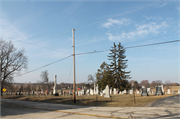Property Record
1700 240TH AVE
Architecture and History Inventory
| Historic Name: | ST. FRANCIS XAVIER CATHOLIC CEMETERY |
|---|---|
| Other Name: | ST. FRANCIS CATHOLIC CEMETERY / ST. PATRICK CEMETERY |
| Contributing: | Yes |
| Reference Number: | 239953 |
| Location (Address): | 1700 240TH AVE |
|---|---|
| County: | Kenosha |
| City: | |
| Township/Village: | Brighton |
| Unincorporated Community: | |
| Town: | 2 |
| Range: | 20 |
| Direction: | E |
| Section: | 14 |
| Quarter Section: | |
| Quarter/Quarter Section: |
| Year Built: | 1843 |
|---|---|
| Additions: | |
| Survey Date: | 2019 |
| Historic Use: | cemetery |
| Architectural Style: | |
| Structural System: | |
| Wall Material: | |
| Architect: | |
| Other Buildings On Site: | |
| Demolished?: | No |
| Demolished Date: |
| National/State Register Listing Name: | Not listed |
|---|---|
| National Register Listing Date: | |
| State Register Listing Date: |
| Additional Information: | The first Catholic church in the Town of Brighton was named St. Patrick’s and was established by the Irish immigrant population in 1838 on the future site of St. Francis Xavier Catholic Church. A cemetery was established there in 1843 AHI #239953. The first, non-extant church building, constructed with logs in 1845, was replaced with a non-extant frame structure and non-extant school in 1857. A steeple and addition to the church were completed in 1860. As the parish grew, many German Catholic immigrants joined the otherwise ethnically Irish church, and the two groups coexisted. A new non-extant school and non-extant convent were constructed in 1879. During the mid- to the late nineteenth century, many German immigrants to the United States erected decorative wrought iron crosses as burial monuments. A number of these crosses #AHI 239954 can be found in the St. Francis Xavier Catholic Church Cemetery. Some of the crosses in the cemetery are stamped “Burlington,” and therefore were likely produced by the foundry of Hubert Wagner in Burlington, Wisconsin. The church was destroyed by a tornado in 1883, and a new Gothic Revival style church was completed in the same year #AHI 239959. The new church was officially renamed after St. Francis Xavier in honor of the prominent Father Francis Etchmann, who had led the church through most of its history up to that point. Previously, the church was known by the Irish parishioners as St. Patrick’s and by German parishioners as St. Boniface. The three stained glass windows above the alter, therefore, depict all three of these saints. The rectory building, located north of the church, was completed in 1906 AHI #12820. A parish hall and shrine addition were constructed on to the church in 1924. The non-extant Martin Hahn Memorial Hall was constructed adjacent to the church in 1924 and demolished in 1972. The church was remodeled in 1962. A new school AHI #239958 and convent AHI #239957 were completed in 1966, and the rectory was renovated the same year. Several outbuildings on the grounds include a garage adjacent to the rectory AHI #239955 and shed behind the school AHI #239956. The interior of the church was renovated in 1999. |
|---|---|
| Bibliographic References: | “History of St. Francis Xavier,” Kenosha-Racine County Line Catholic Parishes website www.krcatholics.org/history-of-st-francis-xavier. |
| Wisconsin Architecture and History Inventory, State Historic Preservation Office, Wisconsin Historical Society, Madison, Wisconsin |

